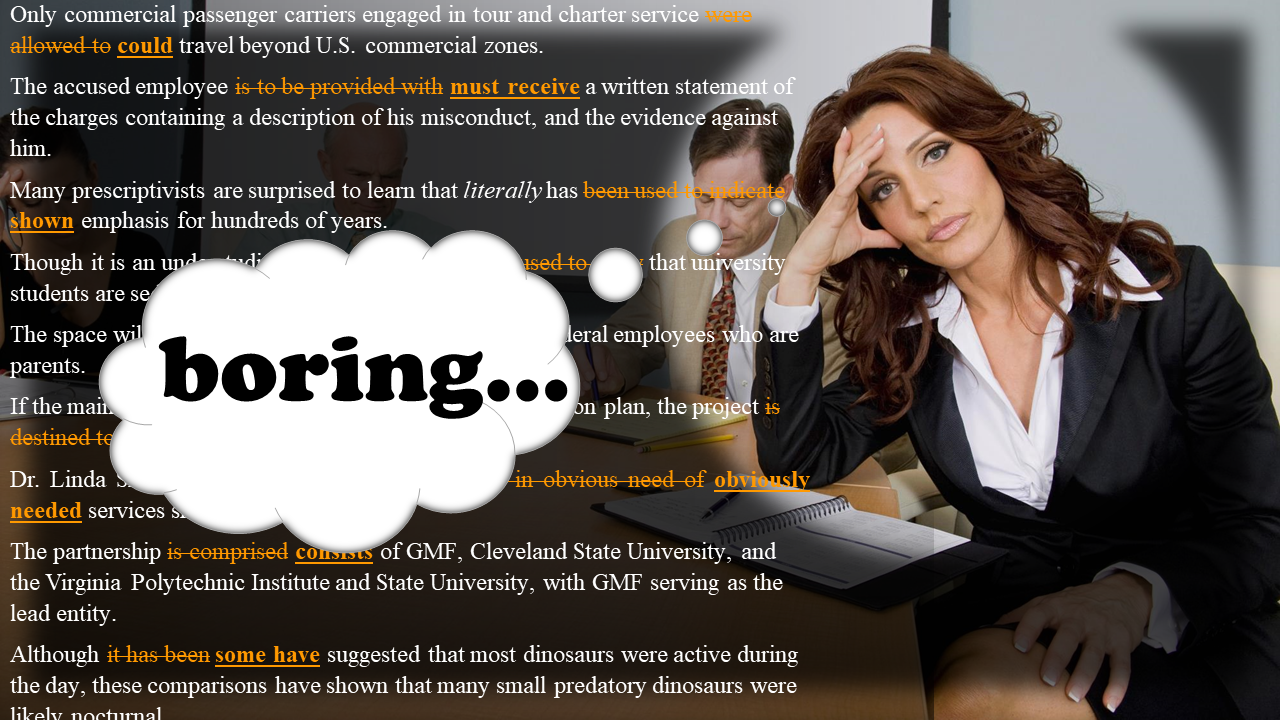Everyone remembers their high school English teachers admonishing them against using the dreaded passive voice. According to composition class lore, using passive voice was the chief writing sin—and avoiding it was the key to strengthening writing. If true, then two questions remain:
- What is passive voice, anyway? (Don’t worry: Even the most pedantic folks can get it wrong!)
- How do we re-write sentences to avoid passive voice? (What good is pointing out a writing ill without offering a writing cure?)
In this blog post, we’ll give you a refresher on passive voice, show you how to fix it, and explain the four times when passive voice is acceptable in your writing.
What Is Passive Voice?
Passive sentences (also called the passive voice, passive constructions, and passive grammar) use some form of be with a past participle. The past participle shows the semantic action verb (the action that someone or something did), but it’s not the main grammatical verb of the sentence. The actor (the person or thing doing the action) isn’t the grammatical subject; the actor (also called the agent) is either not in the sentence or comes after the word by.
Passive sentence: The contract was signed by the two parties.
Grammatical subject: the contract
Semantic (actual) actor / agent: the two parties
Main grammatical verb: was
Semantic (actual) action: signing
In the clearest sentences, the grammatical subject and the semantic (actual) subject are the same, and the main grammatical verb and the semantic verb are the same. Here’s an active (and clearer) version of the passive sentence above:
Active sentence: The two parties signed the contract.
Grammatical subject: the contract
Semantic (actual) actor: the parties
Main grammatical verb: signed
Semantic (actual) action: signing
When to Use Passive Voice
While overusing passive voice or using it unnecessarily will annoy your reader and weaken your writing, passive voice is not universally wrong. Almost every language in the world has passive voice. If passive voice is part of every language, then it must have some value and utility. Here are common reasons why people use passive constructions:
1. When we don’t know who did something:
The store was robbed.
A ball was kicked over our fence.
2. When we don’t want to say who did something and/or attribute responsibility:
Mistakes were made.
The case was mishandled.
3. When it’s obvious or not important to say who did something (or when the semantic object is more relevant):
The party was held in the restaurant’s banquet room.
The house was built in 1985.
4. This relevance is part of the reason people avoid we or I as a subject in academic articles or other formal documentation:
The experiment was replicated successfully.
The test was performed on 5309 subjects.
With these four exceptions to the admonishments against passive voice, here’s WordRake’s version of your teacher’s advice: If you’re not using the passive voice intentionally, clarify your sentence by using an active verb.
How WordRake Eliminates Passive Constructions
Many writers think that passive constructions automatically make their writing sound more formal and therefore more convincing; however, English sentences pack a stronger punch when as much information as possible fits into a single main verb.
Eliminate Weak, Wordy Verb Phrases
To increase impact and reduce passive voice, WordRake offers edits to make your writing clearer and more concise. The software often makes sentences shorter by reducing unnecessary verbs (many of which are passive) and by changing wordy or abstract constructions (many of which are passive) to a more concrete verb.
Examples of Clarifying and Condensing Passives:
Only commercial passenger carriers engaged in tour and charter service were allowed to could travel beyond U.S. commercial zones.
The accused employee is to be provided with must receive a written statement of the charges containing a description of his misconduct, and the evidence against him.
Many prescriptivists are surprised to learn that literally has been used to indicate shown emphasis for hundreds of years.
Though it is an understudied topic, there is evidence used to show that university students are sedentary.
If the main stakeholders don’t participate in the revitalization plan, the project is destined to will fail.
Dr. Linda Smith was an MD, and Rodrigues was in obvious need of obviously needed services she could render.
The partnership is comprised consists of GMF, Cleveland State University, and the Virginia Polytechnic Institute and State University, with GMF serving as the lead entity.
Note that WordRake’s software does not change all passive sentences to active sentences. That kind of an edit would be impossible in sentences without by. It would also be incorrect when writers have intentionally used the passive voice.
Cut Wasteful Stand-In Subjects
You can also rely on WordRake to catch passive constructions with the dummy subject it, which many writers do not recognize as passive. WordRake handles different constructions in different ways to produce condensed but still nuanced edits.
Examples of Eliminating Stand-In Subjects:
Although it has been some have suggested that most dinosaurs were active during the day, these comparisons have shown that many small predatory dinosaurs were probably nocturnal.
It is thought that small Small amounts of water may have gotten into cracks, inducing mineralization.
It is his final contention He contends that we can't afford to go one more day without a strategy.
Strengthen Sentences by Choosing Stronger Verbs than Be
Some sentences are semantically passive when be is the main verb and the grammatical subject is not an actor OR an object. More broadly, the verb be and its conjugations (am, is, are, was, were, has been, etc.) create a weak sentence when no action verbs come with it. Think of be as an equal sign in your sentence when it stands alone in your writing. If be is your only verb in a sentence, can you find a way to make the sentence stronger? If not, don’t worry. WordRake often can.
Examples of Sentences Strengthened by Replacing "Be":
The intent of the general contractor was intended to complete construction quickly.
The intention of the accountant accountant’s intention is to audit last year's records.
His testimony is different differs from his wife’s, yet she is his only source of information.
In-house counsel determined whether the company's business operations were compliant complied with relevant rules and regulations.
While some passive constructions serve specific purposes, others make your writing unnecessarily clunky and wordy. Let WordRake empower your writing today. Start your free seven-day trial by visiting wordrake.com/trial.
About the Author
Danielle Cosimo is a Language Usage Analyst for WordRake. Before joining the team, she was a translator and editor for non-native English speakers applying to degree programs in the United States and the UK. Danielle is formally trained in linguistics and has a certificate in computer programming. She is fluent in English, Portuguese, and Spanish. She applies her interdisciplinary knowledge to create WordRake’s editing algorithms.









